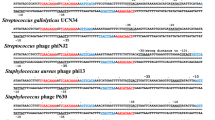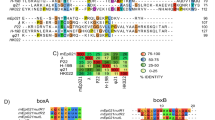Summary
The temperate, transposable bacteriophages D108 and Mu are highly homologous, but differ in their left-end regulatory regions. We have previously cloned the gene encoding the D108 thermo-sensitive (cts) repressor under the control of thelacUV5 promoter. In this work, we report that crude protein extracts containing highly-expressed D108 repressor protect a 77 bp region of DNA, located between 863 bp and 940 bp from the D108 left-end, from both exonuclease III and DNase I hydrolysis. Nucleotide sequence analysis of this region reveals that it also contains DNA sequences homologous to the consensus DNA-binding site of theEscherichia coli protein, Integration Host Factor (IHF). Crude protein extracts containing highly-expressed IHF specifically bind to, and retard the migration of, DNA fragments containing the D108 regulatory region, and the DNA sequence which IHF protects from DNase I cleavage lies directly within the D108 repressor binding region. There are two apparent repressor-specific S1 nuclease-resistant RNAs observed during the lysogenic and lytic states. A single S1 nuclease-resistant RNA suggests that transcription from the early region promoter, Pe, may initiate at or about 1000 bp from the left-end of the D108 genome. Thus, though D108 and Mu utilize three analogous proteins (repressor, ner, and IHF) and the same apparent promoters for early gene regulation and the lytic/ lysogenic decision, the organization of these regulatory components is apparently different, suggesting different mechanisms of control of gene expression.
Similar content being viewed by others
References
Craig NL, Nash HA (1984)E. coli integration host factor binds to specific sites in DNA. Cell 39:707–716
Craigie R, Mizuuchi H, Mizuuchi K (1984) Site-specific recognition of the bacteriophage Mu ends by the Mu A protein. Cell 39: 387–394
Davis MA, Simons RW, Kleckner N (1985) Tn10 protects itself at two levels from fortuitous activation by external promoters. Cell 43: 379–387
DuBow MS (1987) Transposable Mu-like phages. In: Symonds N, Toussaint A, van de Putte P, Howe MM (eds) Phage Mu. Cold Spring Harbor Laboratory Press, Cold Spring Harbor, New York, pp 201–213
DuBow MS, Bukhari AI (1981) The proteins of bacteriophage Mu: Composition of the virion and biosynthesisin vivo during lytic growth. In: DuBow MS (ed) Bacteriophage assembly. Alan R. Liss, New York, pp 47–67
Friden P, Voelkel K, Sternglaz R, Freundlich M (1984) Reduced expression of the isoleucine and valine enzymes in integration host factor mutants ofE. coli. J Mol Biol 172: 484–489
Friedman D, Olsen E, Carver D, Gellert M (1984) Synergistic effect ofhimA andgyrB mutations: Evidence that Him functions control expression ofilv andxyl genes. J Bacteriol 157: 484–489
Fuller F (1982) A family of cloning vectors containing thelacUV5 promoter. Gene 19: 43–54
Galas DJ, Schmitz A (1978) DNasel foot-printing: A simple method for the detection of DNA binding specificity. Nucleic Acids Res 5: 3157–3170
Gill GS, Hull RC, Curtiss III RA (1981) Mutator bacteriophage D108 and its DNA: An electron microscopic characterization. J Virol 37: 420–430
Goosen N, van de Putte P (1984) Regulation of Mu transposition I. Localization of the presumed recognition sites forhimD andner functions controlling bacteriophage Mu transcription. Gene 30: 41–46
Goosen N, van Heuvel M, Moolenaar GF, van de Putte P (1984) Regulation of Mu transposition II. TheEscherichia coli himD protein positively controls two repressor promoters and the early promoter of bacteriophage Mu. Gene 32: 419–426
Gough JA, Murray NE (1983) Sequence diversity amoung related genes for recognition of specific targets in DNA molecules. J Mol Biol 166: 1–19
Hattman S, (1982) DNA methytransferase-dependant transcription of the phage Mumom gene. Proc Natl Acad Sci USA 79: 5518–5521
Hawley D, McClure WR (1983) Compilation and analysis ofEscherichia coli promoter DNA sequences. Nucleic Acids Res 11: 2237–2255
Hull RC, Gill RS, Curtis III RA (1978) Genetic characterization of a Mu-like bacteriophage, D108. J Virol 27: 513–518
Isberg RR, Lazaar AL, Syvanen M (1982) Regulation of Tn5 by the right-repeat proteins: Control at the level of the transposition reaction? Cell 30: 883–892
Krause HM, Higgins NP (1985) On the Mu repressor and early intermediates of DNA transposition. Cold Spring Harbor Symp Quant Biol 50: 827–834
Krause HM, Higgins HP (1986) Positive and negative regulation of the Mu operator by Mu repressor andEscherichia coli integration host factor. J Biol Chem 261: 3744–3752
Krause HM, Rothwell MR, Higgins NP (1983) The early promoter of bacteriophage Mu: Definition of the site of transcription initiation. Nucleic Acids Res 11: 5483–5495
Leong JM, Nune-Duby S, Lesser CF, Youderian P, Susskind MM, and Landy A (1985) The ϕ80 and P22 attachment sites. J Biol Chem 260: 4468–4477
Levin DB, DuBow MS (1987) Cloning and localization of the repressor gene (c) of the Mu-like transposable phage D108. FEBS Lett 222: 199–203
Lowry OH, Rosebrough NJ, Farr AL, Randall RJ (1951) Protein measurement with folin phenol reagent. J Biol Chem 193: 265–275
Magazin M, Reeve NJ, Maynard-Smith S, Symonds N (1978) Bacteriophage Mu encoded polypeptides synthesized in infected cells. FEMS Microbiol Lett 4: 5–9
Maniatis T, Fritsch EF, Sambrook J (1982) In: Molecular cloning. A laboratory manual. Cold Spring Harbor Laboratory Press, Cold Spring Harbor, New York
Maxam AM, Gilbert W (1980) Sequencing end-labelled DNA with base-specific chemical cleavage reactions. Methods Enzymol 65: 499–560
Miller JH (1972) In: Experiments in molecular genetics. Cold Spring Harbor Laboratory Press, Cold Spring Harbor, New York
Miller HI, Friedman DI (1980) AE. coli gene product required for λ site-specific recombination. Cell 20: 711–719
Miller HI, Kirk M, Echols H (1981) SOS induction and autoregulation of thehimA gene for site-specific recombination inEscherichia coli. Proc Natl Acad Sci USA 78:6754–6760
Mizuuchi M, Weisberg RA, Mizuuchi K (1986) DNA sequence of the control region of phage D108: The N-terminal amino acid sequences of repressor are similar both in phage D108 and in its relative, phage Mu. Nucleic Acids Res 14: 3813–3825
Nash HA, (1981) Integration and excision of bacteriophage λ: The mechanism of conservative site-specific recombination. Annu Rev Genet 15: 143–167
Nash HA, Robertson CA, Flamm E, Weisberg RA, Miller HI (1987) Production ofE. coli integration host factor, a protein with non-identical subunits. J Bacteriol 169: 4124–4127
Pfeifer K, Arcangioli B, Guarente L (1987) Yeasthap1 activator competes with the factor RC2 for binding to the upstream activation site UAS1 of thecyc1 gene. Cell 49: 9–18
Priess H, Kamp D, Kahmann R, Brauer B, Delius H (1982) Nucleotide sequence of the immunity region of bacteriophage Mu. Mol Gen Genet 186: 315–321
Roberts D, Hoopes C, McClure WR, Kleckner N (1985) Tn10 transposition is regulated by DNA adenine methylation. Cell 43: 117–130
Ross W, Shore SH, Howe MM (1986) Mutants ofEscherichia coli defective for replicative transposition of bacteriophage Mu. J Bacteriol 167: 905–919
Schneider TD, Stormo GD, Gold L, Ehrenfeucht A (1986) Information content of binding sites on nucleotide sequences. J Mol Biol 188: 415–431
Shinder G, Tourjman S, DuBow MS (1984) Bacteriophage Mu transposition as a tool to identify new classes of genotoxic agents. In: Liu D, Dutka BJ (eds) Toxicity screening procedures using bacterial systems. Marcel Dekker, New York, pp 295–308
Strauss F, Varshavsky A (1984) A protein binds to a satellite DNA repeat at three specific sites that would be brought into proximity by DNA folding in the nucleosome. Cell 37: 889–901
Symonds N, Toussaint A, van de Putte P Howe MM (1987) In: Phage Mu. Cold Spring Harbor Laboratory Press, Cold Spring Harbor, New York
Szatmari GB, Kahn JS, DuBow MS (1986) Orientation and sequence analysis of right-ends and target sites of bacteriophage Mu and D108 insertions in the plasmid pSC101. Gene 41: 314–319
Taylor AL (1963) Bacteriophage-induced mutations inEscherichia coli. Proc Natl Acad Sci USA 50: 1043–1051
Tolias PP, DuBow MS (1985) The cloning and characterization of the bacteriophage D108 regulatory DNA-binding protein ner. EMBO J 4: 3031–3037
Tolias PP, DuBow MS (1986) The over-production and characterization of the bacteriophage Mu regulatory DNA-binding protein ner. Virology 148: 298–311
Waggoner BT, Pato ML (1978) Early events in the replication of Mu prophage DNA. J Virol 27: 587–594
Weisberg RA, Landy A (1983) Site-specific recombination in phage lambda. In: Roberts J, Stahl F, Weisberg R (eds) Lambda II. Cold Spring Harbor Laboratory Press, Cold Spring Harbor, New York, pp 221–250
Weiss B (1976) Exonuclease II ofEscherichia coli is exonuclease III. J Biol Chem 251: 1896–1902
Wijffelman C, Lotterman B (1977) Kinetics of Mu DNA synthesis. Mol Gen Genet 151: 169–174
Wijffelman C, Gassler M, Stevens WF, van de Putte P (1974) On the control of transcription of bacteriophage Mu. Mol Gen Genet 131: 85–96
Wu C (1985) An exonuclease III protection assay reveals heat-shock element and TATA-box DNA-binding proteins in crude extracts. Nature 317: 84–85
Author information
Authors and Affiliations
Additional information
Communicated by D.Y. Thomas
Rights and permissions
About this article
Cite this article
Levin, D.B., DuBow, M.S. Regulation of repressor and early gene expression in Mu-like transposable bacteriophage D108. Molec. Gen. Genet. 217, 392–400 (1989). https://doi.org/10.1007/BF02464909
Received:
Issue Date:
DOI: https://doi.org/10.1007/BF02464909




